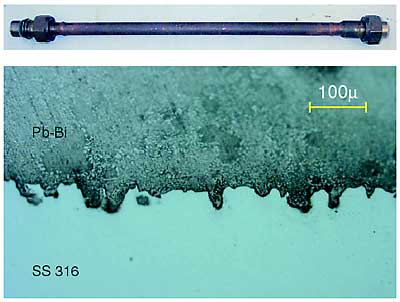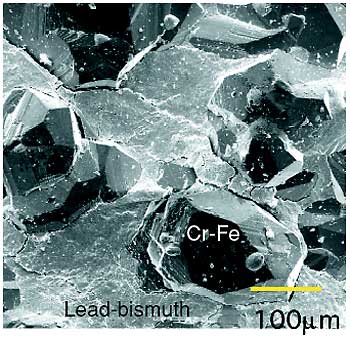A conceptual nuclear transmutation facility has been designed to carry out an experiment for reducing long-lived radioactive nuclei to short ones, which were produced in nuclear power generation. The facility consists of an accelerator and a sub-critical reactor. Protons accelerated to high energy will collide with the nuclei of the target and will spall them. At the same time many neutrons are generated through the spallation process, and these will be used for nuclear transmutation. Among materials, eutectic Pb-Bi is selected as a primary candidate for the spallation neutron source from the point of view of material properties such as atomic density, melting temperature and boiling temperature. The facility concept has a new idea differing from a conventional reactor system since there is a spallation target as an interface connecting the two systems of accelerator and sub-critical reactor.
The target containment material is influenced by flowing Pb-Bi at elevated temperatures as well as incident protons and neutrons produced by spallation reactions. In order to realize the target material, an appropriate database is necessary. We intend to evaluate the influence of corrosion under a flowing Pb-Bi condition independent of the influence of radiation. Also we carried out a flowing Pb-Bi test for 3000 h at elevated temperatures and examined the material performance.
Resistance of materials against corrosion is generally enhanced by an oxide layer,
which is formed on the material surface. The candidate material for target containment
is the austenitic stainless steel (SUS316). The corrosion test of SUS316 in stagnant
Pb-Bi showed a stable property such that the oxide layer was formed at a depth
of a few micronmeters and no scale-off was detected. In the flowing Pb-Bi at the
same temperature with the stagnant corrosion test, however, SUS316 was erosion-corroded.
This means that the oxide layer does not always cover the material surface for
flowing Pb-Bi. The detailed analyses showed that the depth of attacked matrix
is maximally 100 mm, Pb-Bi adhered to the material surface even after a drain
out of Pb-Bi (Fig. 5-3) and Cr-Fe crystals precipitated in the Pb-Bi which adhered
to the relatively low temperature part, 400degree Celsius, of the flowing channel
in the circulation loop (Fig. 5-4). The depth of erosion corrosion is an important
value for design life assessment. Consideration was done on the mechanism of Cr-Fe
precipitation. It is concluded that Fe and Cr were melted into Pb-Bi from SUS316
in the high temperature part, and deposited in the low-temperature part according
to the difference of solubility. It suggests a potential plugging of a narrow
channel for flowing Pb-Bi in the tubes of a steam generator or a heat exchanger
for real transmutation plants. So sufficient gaps must be designed in the nuclear
transmutation facility. |


